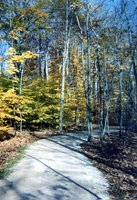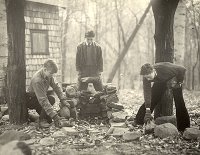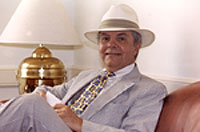 On a tip from Don Husat '64 about the ruins of an old dam in Hudson's Bicentennial Woods, we went on a field trip in early November with Lynna Piekutowski (who wrote Remembering the Boys) and discovered more than we had expected. After fording a couple of small brooks and climbing up an embankment, we looked carefully at the remains of the old stone dam probably built when this area was part of WRA benefactor James W. Ellsworth's East Woods.
On a tip from Don Husat '64 about the ruins of an old dam in Hudson's Bicentennial Woods, we went on a field trip in early November with Lynna Piekutowski (who wrote Remembering the Boys) and discovered more than we had expected. After fording a couple of small brooks and climbing up an embankment, we looked carefully at the remains of the old stone dam probably built when this area was part of WRA benefactor James W. Ellsworth's East Woods. Then on a small rise a few hundred feet from the dam, we spied a group of bricks scattered about in the fallen leaves and went for a look. The more we dug into the old foundation, the more convinced we were that we had found the location of the Senior Cabin that had been built as a project by the Class of 1928. This class had the idea but needed to raise funds in order to build their hideaway in the woods.


 For about a year, they raised money by showing movies on the weekend and held other fund raisers that netted them the $645 to cover expenses for construction (this at a time when WRA tuition was $800 per year). In the fall of 1927, they began construction under the watchful eye of faculty member Ralph B. Simon. They were allowed to dismantle an old chicken coop at Evamere Farm and take the timbers, which became the framework for their cabin, out to the woods. We believe the location near the dam made sense, as there would have been a small pond there at the time, and nothing but woods and fields between the cabin and Evamere Farm near the intersection of Aurora and Hudson Streets.
For about a year, they raised money by showing movies on the weekend and held other fund raisers that netted them the $645 to cover expenses for construction (this at a time when WRA tuition was $800 per year). In the fall of 1927, they began construction under the watchful eye of faculty member Ralph B. Simon. They were allowed to dismantle an old chicken coop at Evamere Farm and take the timbers, which became the framework for their cabin, out to the woods. We believe the location near the dam made sense, as there would have been a small pond there at the time, and nothing but woods and fields between the cabin and Evamere Farm near the intersection of Aurora and Hudson Streets. We knew there were photos (below) in WRA Archives documenting this project, which was completed in the spring of 1928 when the class hosted Headmaster Ralph Boothby at a picnic at the site. The class planned to use it for reunion picnics, but deeded it over to the Class of 1929 and their successors. Our records show that it was used intermittently (no overnight stays without faculty supervision) through 1937.
By 1940, the cabin had fallen into disrepair and an effort was launched to repair it and put it back into use. Whether that ever happened is not known. World War II came along, and those boys who may have wanted to hike in the East Woods found themselves hiking across battlegrounds in Europe or the Pacific.


In 1951 the school began to
dismantle Evamere Farm, and by 1955 had begun selling off large parcels of the farm and the extensive woods that adjoined it. A significant portion of the farm property is now home to community schools and private residences.
In the early 1970s, the Hudson Park Board also acquired a section of this area. Later, during the American Bicentennial of 1976, the area encompassing the stone dam and Senior Cabin ruins was purchased and presented to the Park Board.
